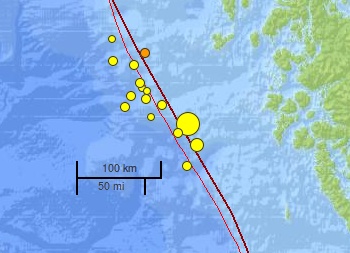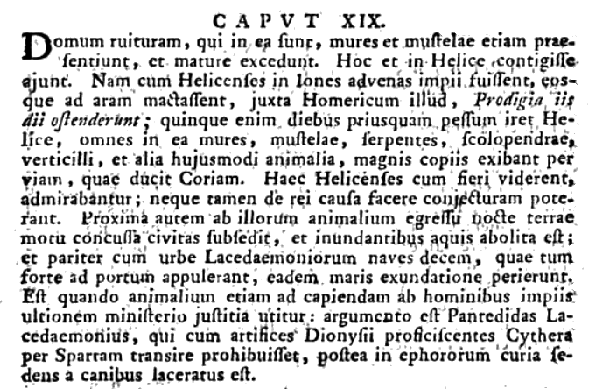Earthquake Prediction
January 16, 2013
There was a
magnitude 7.5
earthquake on January 5, 2013, about 94
kilometers west of
Craig, Alaska.[1] Fortunately, it caused no damage, and there were no deaths. Although large magnitude earthquakes like this are infrequent, their personal and
economic consequences can be huge, as the
2011 Tohoku earthquake and concurrent
tsunami have shown.
No place is really free from earthquakes. On February 2, 2009, a magnitude 3.0 earthquake occurred with an
epicenter just seven
miles from my house, located in a generally earthquake-free region of
Northern New Jersey.[2]

Epicenter (largest circle) and aftershocks of the January 5, 2013, earthquake off the coast of Alaska.
In this chart, the quake magnitude is represented by the circle diameter.
(USGS image))
I wrote about
earthquake prediction in two previous articles (
Earthquake Prediction, February 18, 2011 and
Earthquake Warning, March 27, 2012). Although
humans have become increasingly able to predict the
weather, we're far from being able to predict earthquakes.
It's interesting that
animals appear to be better at earthquake prediction than humans. Such a trait would offer an
evolutionary advantage, so it might have been perfected by
natural selection. Some
birds and
bacteria have been found to have
magnetic receptors, so that might be one possible mechanism. Animals may also respond to changes in
electric field strength. There are many
anecdotes about animal prediction of earthquakes.
One such anecdote was told by
Claudius Aelianus, a
Roman author who lived around 300
AD. Aelianus wrote in
Greek, although he is mostly known through the many
Latin translations of his works. One of his popular works,
Varia Historia (ποικιλη 'Ιστορια, "Various History") is best known for its exposition of
fly fishing. It mentions the use of
lures constructed from
wool and
feathers.
De Natura Animalium (Περι Ζωων 'Ιδιοτητος, "On the Characteristics of Animals") by Aelianus contains a description of the destruction in 373
BC of the
Greek city of Helike by an earthquake and tsunami. The description of the event, in Book X1, Chapter XIX,[3] is shown in the figure. My translation (up to "et pariter cum urbe...") is as follows:
When a house falls to ruin, this is foreseen by the mice and weasels who are there, and they quickly leave. They say that this happened in Helice. For wicked things befell the Helice people in Ionia, and their divination through sacrifices on the altar, like those in Homer, foretold these. Five days before Helike disappeared, all the mice, weasels, snakes, centipedes and beetles, and all other such creatures, left en masse by the road that leads to Coria. The people of Helice saw these things as they happened, and they were awestruck, not knowing the cause or even guessing the reason. However, soon after these creatures had departed, an earthquake occurred in the night, the city subsided, and it was destroyed by a flood of water.

Changing
water level in
wells was also seen in
antiquity as an
earthquake precursor. Other possible detection techniques have appeared in our technological age, including
• Radon dissolved in well water.
• Changes in electrical noise caused by the piezoelectric effect in rock under stress.
• Fractoluminescence, in which the electric fields caused by separation of mineral crystal planes will generate light.
• High intensity ultralow frequency (ULF) radio signals.
• Satellite remote sensing of electromagnetic fields.
ULF signals as a possible precursor for earthquakes was an accidental discovery by
Antony Fraser-Smith, an
electrical engineer at
Stanford University, and his
graduate student. They were studying ULF radio waves in the frequency range of 0.01 to 10
hertz produced when the
solar wind interacts with
Earth's magnetosphere.[4]
Twelve days before the
Loma Prieta earthquake of 1989, Fraser-Smith and Arman Bernardi, his student, recorded a high intensity ULF signal; and then, three hours before the earthquake, there was a ULF signal 20-30 times larger than the typical signal level.[4] ULF precursors to earthquakes have been detected by satellites.[5-8] ULF signals can penetrate tens of miles into the
Earth with little loss.
Geophysicists are looking at other electrical signals closer to the ground. One poster[9] presented at the
2012 Fall Meeting of the
American Geophysical Union (December 3-7, 2012,
San Francisco) describes a multisensor approach focused primarily on the magnetic fields produced by
electrical discharges within the Earth. As described online by
National Geographic,
Stellar Solutions (
Cambridge, Massachusetts) is working on a
QuakeFinder project.[10] A magnitude six earthquake seems to produce an electrical current of about 100,000 amperes, and a magnitude seven earthquake will produce about double that.[10]
As
Faraday found, where there's electrical current, there's also a magnetic field, so the QuakeFinder has been placing
magnetometers along
faultlines in
California, and in other countries. These magnetometers can detect such electrical discharges at 16 kilometer (10 mile) depths. These detect a background signal of about ten pulses per day, but this rate increases to more than a hundred per day two weeks before a major earthquake; then, there's a period before the quake when the rate is reduced to the background level.[10]
Since there's a problem with false signals caused by surface effects, other sensors are deployed to sort things out. The QuakeFinder team has been building a
statistical database, and they've reached the point at which they think they can make forecasts.[10] They would be wise to
avoid making predictions in Italy.[11]
References:
- Magnitude 7.5 Earthquake, 94 km W of Craig, Alaska 2013-01-05 08:58:16 UTC, US Geological Survey Earthquake Web Site.
- Trymaine Lee, "Small Earthquake Rattles New Jersey," New York Times, February 3, 2009.
- Claudius Aelianus, "De natura animalium," 1784, Digitized by Google Books from an original at the University of Lausanne, April 1, 2008, p. 149.
- Scientists debate new evidence for electromagnetic earthquake predictors, Stanford University News Service, December 31, 1991.
- Spacecraft Saw ULF Radio Emissions over Haiti before January Quake, arXiv Blog, December 9, 2010.
- F. Muto, M. Yoshida, T. Horie, M. Hayakawa, M. Parrot, and O. A. Molchanov, "Detection of ionospheric perturbations associated with Japanese earthquakes on the basis of reception of LF transmitter signals on the satellite DEMETER," Natural Hazards and Earth System Sciences, vol. 8, no. 1 (February 26, 2008), pp. 135-141.
- M. Athanasiou, G. Anagnostopoulos, A. Iliopoulos, G. Pavlos and K. David, "Enhanced ULF radiation observed by DEMETER two months around the strong 2010 Haiti earthquake," arXiv Preprint Server, December 7, 2010.
- F. Muto, M. Yoshida, T. Horie, M. Hayakawa, M. Parrot, and O. A. Molchanov, "Detection of ionospheric perturbations associated with Japanese earthquakes on the basis of reception of LF transmitter signals on the satellite DEMETER," Natural Hazards and Earth System Sciences, vol. 8, no. 1 (February 26, 2008), pp. 135-141.
- Poster NH41B, "Multisensors Observations of Pre-Earthquake Signals and Their Connection with Major Seismicity," 2012 Fall Meeting of the American Geophysical Union, San Francisco, December 6, 2012. (Note-The link is to a large PDF file of the program booklet)
- Richard Lovett, "Scientists Seek Foolproof Signal to Predict Earthquakes," National Geographic News, January 4, 2013.
- Tia Ghose, "L'Aquila Earthquake Forces Geologists to Rethink Risk," LiveScience, December 11, 2012.
Permanent Link to this article
Linked Keywords: Moment magnitude scale; magnitude; earthquake; kilometer; west; Craig, Alaska; economy; economic; 2011 Tohoku earthquake; tsunami; epicenter; mile; Morris County, New Jersey; Northern New Jersey; USGS; earthquake prediction; human; weather; animal; evolution; evolutionary advantage; natural selection; bird; bacteria; magnetic field; sensory receptor; receptor; electric field; anecdotal evidence; anecdote; Claudius Aelianus; Roman Empire; Roman; author; Anno Domini; AD; Greek language; Latin; fly fishing; lure; wool; feather; BC; Greece; Greek; city of Helike; groundwater; water level; well; ancient history; antiquity; earthquake precursor; radon; electrical noise; piezoelectricity; piezoelectric effect; fractoluminescence; electric field; mineral; crystal plane; ultralow frequency (ULF) radio signals; satellite; remote sensing; electromagnetic field; Antony Fraser-Smith; electrical engineer; Stanford University; graduate student; hertz; solar wind; Earth's magnetosphere; Loma Prieta earthquake of 1989; Earth; geophysics; geophysicist; 2012 Fall Meeting; American Geophysical Union; San Francisco; electrical discharge; National Geographic; Stellar Solutions; Cambridge, Massachusetts; QuakeFinder; Michael Faraday; magnetometer; Fault; faultline; California; statistics; statistical; seismology; Italy.